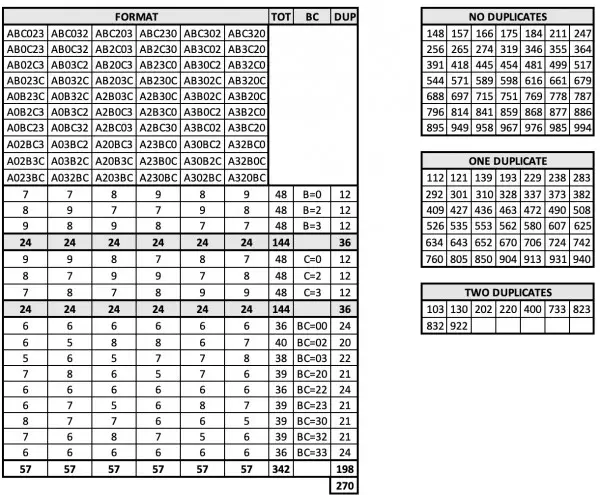
The above tables should help in performing the required calculation.
The 6-digit number must contain the digits 0, 2 and 3 and be divisible by 9. If the sum of the 6 digits is a multiple of 9, then the 6-digit number is divisible by 9. Using this fact we can generate the first 3 digits of the number starting at 103 (in other words, 103000) and incrementing by 9 (that is, by 9000) to give the prefix sequence: 103, 112, 121, ..., 985, 994. There are 100 different prefixes. The last three digits will be 023 and all 6 permutations of these digits. Hence we get 103023, 103032, 103203, 103230, etc., that is, 6 permutations for every prefixed set of digits.
The NO DUPLICATES table above shows all 49 prefixes in which the 2nd and 3rd digits are not 0, 2 or 3. The large table is used to find out how many duplicate mixtures (generating duplicate 6-digit numbers) there are, when the prefix digits are mixed with 0, 2 and 3. The letters ABC represent the digits of the prefix when B and/or C is 0, 2 or 3. When there are no duplicates within BC, there are 10 possible numbers created for each ABC prefix and the digits 0, 2 and 3. These are shown in the FORMAT section of the table. The numbers beneath this table show how many distinctly different numbers there are. When BC doesn't duplicate 0, 2, 3 all 10 arrangements produce distinct numbers. The DUP column shows how many duplicates there are (270 in all); but this number is based on the generic prefix ABC. We have to find out how many actual numbers correspond to the generic quantity.
The NO DUPLICATES table tells us that there are 49 ABC prefixes that have the full complement of 60 arrangements with the permutations of 0, 2 and 3. This accounts for 60×49=2940 numbers.
The remaining 51 prefixes can be divided into two groups with prefixes containing at least one duplicate of the digits 0, 2 or 3. These prefixes are shown in ONE DUPLICATE (42 prefixes) and TWO DUPLICATES (9 prefixes), accounting for 42+9=51 duplicates.
The 42 prefixes have a common value of 48, making 42×48=2016 numbers, while the remaining 9 account for a further 342, as shown. Therefore the total number of 6-digit numbers divisible by 9 containing at least one occurrence of each of 0, 2 and 3 is 49×60+42×48+342=5298.